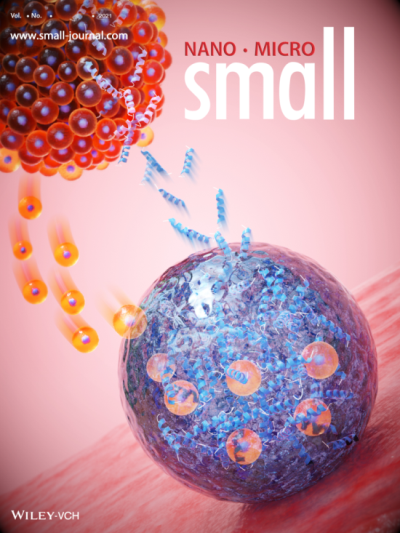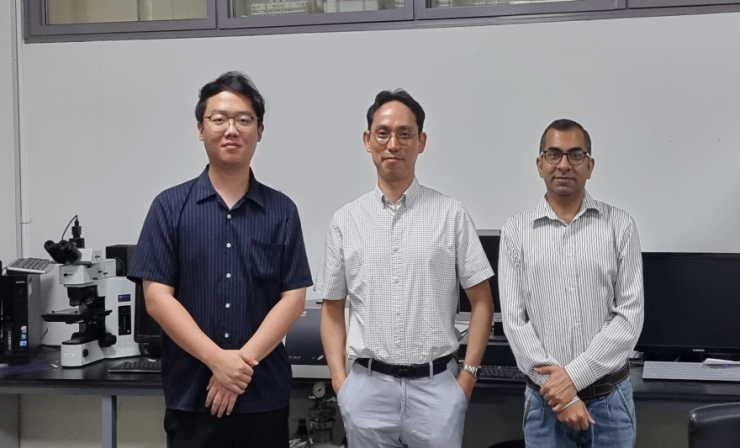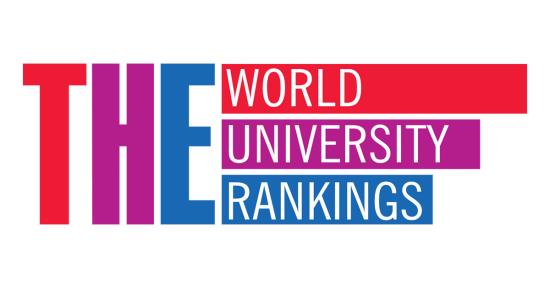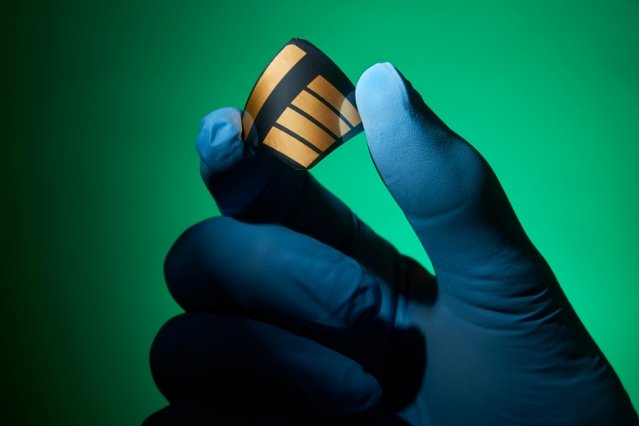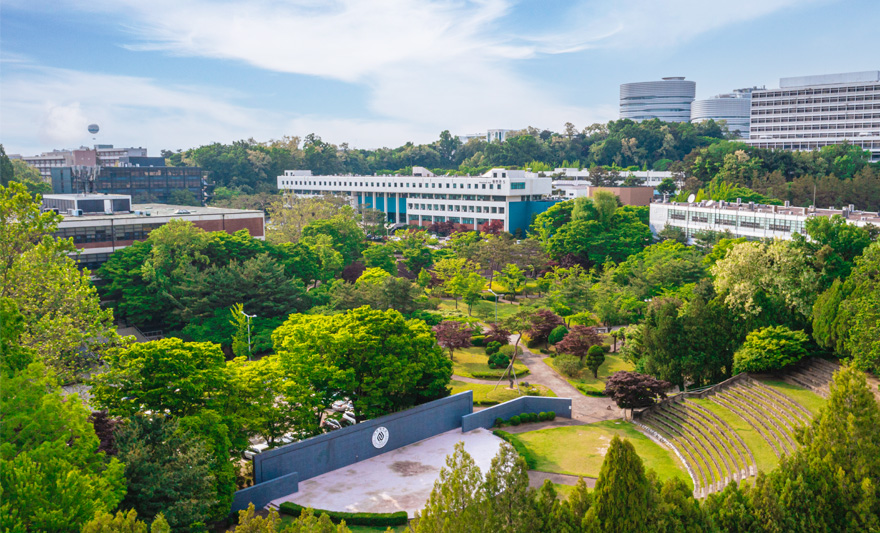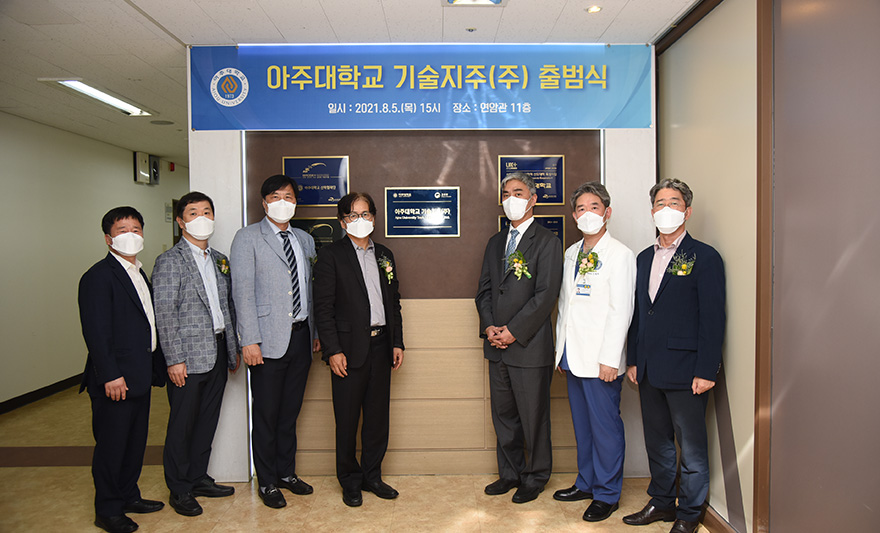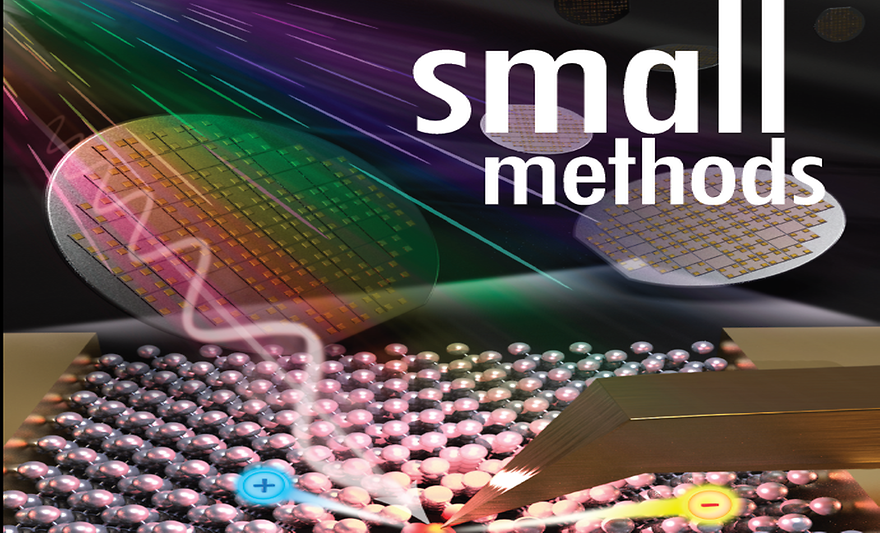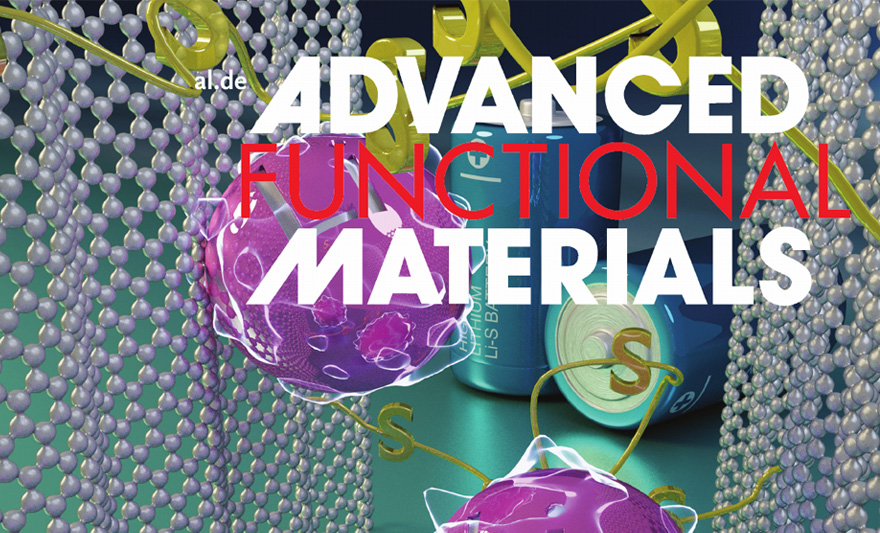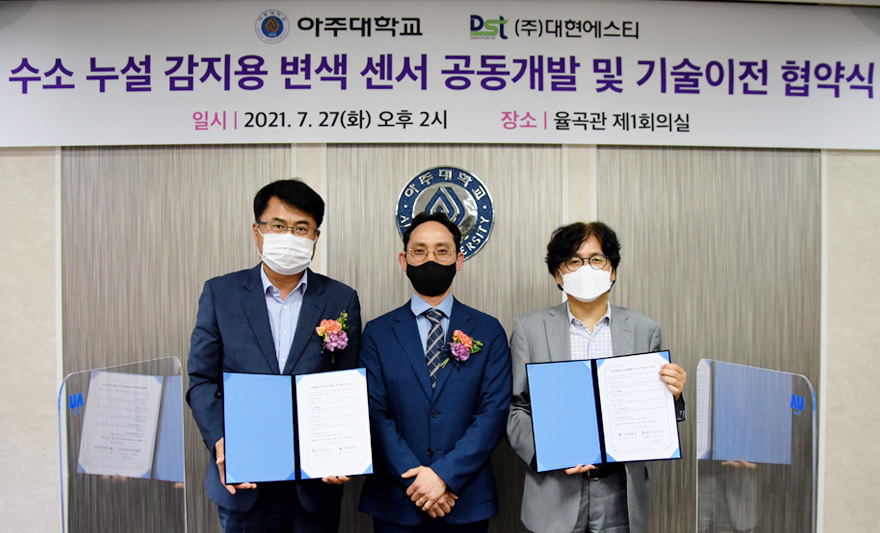-
An Ajou University research team has successfully developed a new peptide that can effectively induce endogenous stem cells that exist in every tissue of the human body. It is expected to have broad applications in the treatment of illnesses, such as myocardial infarction, degenerative arthritis, and rheumatic arthritis, since it can induce the regeneration of damaged human tissue without the injection of external stem cells.The joint research team of Prof. Choi Sang-dun (Department of Biological Sciences, Graduate School Molecular Science and Technology), Prof. Kim Moon-suk (Department of Applied Chemistry and Biological Engineering, Graduate School Molecular Science and Technology), and Medipolymer, Inc. announced the development of a new peptide substance that enables the migration of endogenous stem cells that is two or three times better than existing substances, through molecular pathogenic simulation. Medipolymer is a company developing stem cell treatments for incurable illnesses and self-healing.The results were selected as the cover thesis for the September 4, 2021 online edition of the international journal Small under the title, “Endogenous Stem Cell-Based In Situ Tissue Regeneration Using Electrostatically Interactive Hydrogel with a Newly Discovered Substance P Analog and VEGF-Mimicking Peptide”.Stem cells refer to undifferentiated cells that can differentiate into various types of cells. One stem cell can produce a variety of different cell types, and they have recently emerged as a new alternative for treatment of degenerative illness. In particular, the use of chemoattractant to facilitate tissue regeneration based on endogenous stem cells is at the center of focus. Endogenous stem cells are adult stem cells that exist in all human tissue, and recently, a new treatment is being developed that can control the microenvironment, which controls regeneration and multiplication of endogenous stem cells, without having to inject external stem cells.The research team developed a new peptide substance using substance P (SP) analog as chemoattractant. This is the first study involving the use of substance P analog (SP1), which has been newly developed through molecular pathogenic simulation and assesses the migration of endogenous stem cells.The research team used cationic chitosan and anionic hyaluronic acid to manufacture a substance with properties befitting a loading syringe that had no loss of SP1, and developed a new strategy around static electricity interaction. The SP1 discovered by the team confirmed that SP1 enhanced the migration ability of human mesenchymal stem cells by two or three times that of existing SP.In an animal test, the research team confirmed that SP1 pulled a large number of human mesenchymal stem cells toward the hydrogel, followed by the vascular endothelial growth factor mimetic peptide inducting vasculogenic differentiation. This discovery shows that SP1-loaded hydrogel may be a promising tool to facilitate the regeneration of endogenous stem cell-based tissues.“This new discovery will enable us to endogenously induce the regeneration of damaged human tissue without injecting external substances,” a spokesperson for the research team stated. “It will have dramatic applications in the treatment of illnesses, such as myocardial infarction, degenerative arthritis, and rheumatic arthritis.”The research was sponsored by the Creative Materials Discovery Program of the National Research Foundation of Korea (NRF) and the Research Facility Establishment Program (Molecular Science & Technology Research Center (MSTRC)).In situ tissue regeneration strategy based on endogenous stem cells. “In situ” means “in the original place, in the original position” in Latin. In stem cell research, it is used to refer to directly acting on the lesion requiring tissue regeneration.* Top photo- Selected figure from the research team’s thesis on the cover of Small (September 4, 2021 online edition) / provided by WILEY_VCH
-
533
- 작성자OIA
- 작성일2021-11-16
- 5598
- 동영상동영상
-
A research team led by Ajou University Professor Seo Hyung-tak has successfully developed an AI-based photovoltaic memory device that can imitate human visual capacity and store images and distinguish data. It is expected to find use in the development of artificial neural visual devices and applications in a variety of fields, including intelligent photovoltaic sensors, data processing, and robot engineering.Prof. Seo Hyung-tak (Department of Materials Science and Engineering, Graduate School of Energy Systems, center in photo) announced the development of an optical memory device that can detect optical image signals and store them in the form of non-volatile data, and conduct image storage programming according to input signals. This device is highly transparent and can be independently powered.The results were published in a thesis entitled, “Highly transparent reconfigurable non-volatile multilevel optoelectronic memory for integrated self-powered brain-inspired perception” in the August 27, 2021 online edition of Nano Energy (IF=17.881), an international journal in the field of nano technology. Ajou University’s Professor Mohit Kumar (right in photo) and master’s degree student Lim Jaeseong (left in photo) also took part in the research.The human visual perception system can detect optical signals in real time, and recognizes them differently according to intensity or repetition. Not only does it selectively save the received information in long-term or short-term memory, but it can also discern its importance. Human vision grasps optical information, encodes it into electrical spikes of appropriate sizes through photovoltaic transformation, and delivers the information to the visual cortex in the brain and stores it in the bio synapse network.As such, if the bio visual perception integrating optical signals detection and information storage can be imitated and made into a device, it can process intelligent visual information. With current technology, the optical sensor is separated from an information storage memory device. In addition, signal treatment devices are also needed to identify the meaning of the optical signals, and high-level video processing, primarily intelligent CCTVs, essentially require the composition of complicated hardware. An effective, simple humanoid photoelectric circuit design that can ultimately replace existing complicated circuits is needed to achieve a technological breakthrough. To simplify such circuits, signal processing and memory storage must be integrated so that the device can adjust to diverse environments, discriminate between information and store it.Ajou University’s research team developed Nano film (optical sensor) using high quality titanium dioxide (TiO2), and created a core-shell Nano column array (memory) combined with nickel and nickel oxide (NiO) to overcome this limitation and integrate non-volatile memory and intelligent optical sensor functions. Then, it developed the first-ever heterojunction device that evenly allocates nickel oxide film (optical switch) and silver Nano wire, and placed it in the top layer. The nickel oxide Nano column developed by the research team can securely collect and store photoelectric charges generated by the photoelectric current, serving as the core material for intelligent non-memory.The research team used Nano columns, combined with nickel and nickel oxide, to control the distribution of oxygen vacancy (vacancy created by the lack of oxygen in a metal oxide crystal), thereby ensuring safety. The width of a NiO Nano column is around 20-30 nanometers. In the measurement of photoelectric currents using atomic force microscopy (AFM), optical switching features seemed stable in an area of 30 nanometers, which means it can produce pixel intensity of 716GB per 1-inch area.The research team succeeded in imitating several functions of bio visual perception using the photovoltaic device they developed. It confirmed that the ultraviolet optical pulse signal that is input every 0.1 second can be strengthened or weakened in the long term to create intelligent non-volatile memory storage and programming. The intensity of optical signals, and the polarity and size can be used as variables to store and discern optical signals at multiple levels.The research team’s photovoltaic device can strengthen or weaken data by converting voltage even if the optical pulse signals are of the same intensity and number. This signifies it has the same effect as how visual data repeatedly perceived in a human’s visual perception remains in memory for a long time, whereas a one-time bit of visual data is quickly forgotten. The research team created a 5x5 pixel array with the developed devices and demonstrated how it can discern short messages.“The human visual perception system has an intensely complicated structure that cannot be made with integrated circuit devices using current technology,” said Prof. Seo. “Through this research, we managed to develop a simplified memory integrated optical sensor at the device level, which will be utilized in the future for development of an AI optical perception system.”Prof. Seo added, “With additional research and development, it will ultimately have broad applications, including intelligent CCTV, data processing, and robot engineering.”This research was sponsored by the General and Mid-Career Researcher Support Programs [KHTC1]hosted by the Korean Ministry of Science and ICT (MSIT) and the National Research Foundation of Korea (NRF).[KHTC1]“중견·기본 기초연구지원사업” 임의번역하였습니다.
-
531
- 작성자OIA
- 작성일2021-11-16
- 4401
- 동영상동영상
-
Ajou University ranked in the 601-800 range in THE World University Rankings 2022. Ajou saw improved performance in all fields, including education and research, over last year and tied for 8th place among domestic universities.Ajou University was recently included in the 601-800th rankings in the recently announced THE World University Rankings 2022. THE (Times Higher Education), a UK-based university assessment institution, annually publishes global university rankings along with QS (Quacquarelli Symonds). A total of 2112 universities from 99 countries took part in this year’s assessment.THE published the rankings of the top 1662 universities according to its assessment. Ajou University ranked in the 601-800 tier, similar to last year. It is 8th among domestic universities.Ajou University received scores in all assessment indicators that were higher than last year. THE uses 13 calibrated performance indicators in five sectors: Teaching, Research, Citations, International outlook, and Industry income. Ajou University’s performance saw particular improvement in Research and Citations.The University has been aggressively working to secure leading faculty and strengthen its research abilities, including setting up an “Excellent Thesis Award” based on a quality assessment, increasing research funding for new faculty (up to KRW 100 million in science and engineering and up to KRW 50 million in humanities and social studies), evaluating professor performance using a research quality assessment, awarding research grants to post-doc researchers, inviting notable researchers to Ajou during academic seminars overseas, and other activities.These efforts have led to tangible results, and Ajou University recorded KRW 3.35 billion in income from technology transfers last year, ranking it 7th in Korea, and multiples of the approximately KRW 710 million average income from technology transfers for domestic universities, according to the University Information Disclosure Services. Technology transfers are a major source of income and an indicator of research capacity for universities, where Ajou University has recorded a continuous rise for the past five years. Technology transfer income is revenue earned by the University for businesses to acquire the intellectual property rights to utilize the R&D results of university research teams.THE evaluates universities on Teaching, Research, Citations, International outlook, and Industry income using thirteen performance indicators. In THE World University Rankings 2022, the University of Oxford ranked 1st, followed by Harvard University and California Institute of Technology (tied for 2nd), Stanford University (4th), and University of Cambridge and Massachusetts Institute of Technology (MIT) (tied for 5th).Ajou University continues to see good performance in world university rankings announced by global university assessment institutions. It was included in the 531-540 group in the QS World University Rankings 2022, climbing the rankings for three years in a row. In THE Asia University Rankings 2021, it jumped 49 spots from last year to rank 130.
-
529
- 작성자OIA
- 작성일2021-11-16
- 4549
- 동영상동영상
-
A research team at Ajou University, led by Prof. Kim Jong-hyun, has developed a new approach to manufacturing perovskite solar cells that can generate high amounts of power without external sunshine, heralding the entry of solar cells that can use low-intensity indoor lighting instead. This development makes it possible for such lighting to serve as an independent indoor power source for Internet-of-Things (IoT) devices. Prof. Kim Jong-hyun (Department of Applied Chemistry and Biological Engineering, Graduate School of Molecular Science and Technology) announced that joint research, carried out alongside a research team led by Prof. Jan Seidel and Dr. Jae Sung Yun from Australia’s University of South Wales (UNSW), succeeded in identifying the core design principle of solar cells that can generate highly efficient power using indoor lighting.The joint research was published in the August 26, 2021 online edition of the international journal Advanced Energy Materials (IF29.3=68, JCR rank: 2.78%) and entitled, “Probing Charge Carrier Properties and Ion Migration Dynamics of Indoor Halide Perovskite PV Devices Using Top- and Bottom-Illumination SPM Studies”. Prof. Kim (right in photo) of Ajou University took part as the corresponding author and Shin So-jeong (left in photo), a student in the Master’s/Doctoral Integrated Program at Ajou University Graduate School of Molecular Science and Technology, as the lead author. Prof. Kim also served as advisor.Solar cells convert photovoltaic energy into electric energy, and are at the center of attention with the increase in the use of renewable energy. Existing solar cells were generally studied and developed to improve the conversion efficiency of photovoltaic energy into electric energy. With the recent emergence of the 4th Industrial Revolution, however, the demand for indoor IoT electronic devices for smart farms, smart homes, and smart factories, among others, is rising dramatically, and the development of solar cells for indoor application is being highlighted as a power source to enable their operation.The research team focused on perovskite, which effectively absorbs the light wave band of indoor lights. Perovskite, a hybrid organic/inorganic semi-conductor material with an ABX3 crystal structure, is gaining popularity in solar cells as it makes for highly-efficient energy conversion at low process unit cost. The team also revealed that grain boundary charge traps, which is generated by an interfacial defect in the perovskite layer and the electron transport layer, rapidly lowers the output value of solar cells in an environment with only indoor low-intensity light irradiation. By introducing an electron transport layer able to minimize interfacial defect, the team succeeded in optimizing perovskite solar cell output in an indoor lighting environment.This research finding is significant as it amounts to a discovery of the core design principle of solar cells that are highly-efficient in converting photovoltaic energy to electric energy in a low-intensity light irradiation environment, and suggests a way to develop solar cells that can produce high voltage energy using indoor lighting.“Through this research, we revealed the core principle to optimize conversion efficiency of perovskite solar cells in a low-intensity indoor light irradiation environment,” said Prof. Kim. “We are currently conducting R&D on introducing the high voltage perovskite solar cells we developed as the power source for IoT sensors to monitor the health of livestock at an Australian smart farm.”This research was conducted with grants from the Korea-Australia Strategic International Joint Research Project of the National Research Foundation of Korea (NRF), the Research Facility Establishment Program (Molecular Science and Technology Research Center (MSTRC)), and major programs of the Korea Research Institute of Chemical Technology (KRICT).<Research results on low-intensity output optimization of perovskite solar cells based on analysis and control of interfacial defects >
-
527
- 작성자OIA
- 작성일2021-11-16
- 4548
- 동영상동영상
-
A research team led by Lee Hwang, Professor of Architecture at Ajou University, developed a building façade module that automatically responds to changes in temperature similarly to the way a cactus does—by opening and shutting “stomata” to adjust its own temperature.Prof. Lee’s research team used smart materials and 4D printing to develop a temperature-sensitive building façade (visor) module. Related research findings were announced in the international Journal of Building Engineering on August 8, 2021. 4D printing is a technology that adds a time dimension to 3D printing, which prints three-dimensional shapes, thereby printing materials that change according to time.The research team used shape memory materials that change shape according to temperature to imitate how cacti open and close their stomata. Cacti breathe through their stomata and use them to control light and humidity, thereby helping them survive in the desert. The research team combined shape memory nickel titanium alloy with shape memory high polymer, which allows the shape memory alloy to contract as the temperature rises and close its visor to shut the sunlight out. As the temperature drops, the shape memory high polymer curves outwards to open the visor.With a miniaturized architectural structure, the research team verified that shape memory composite materials can be used to automatically open and shut an exterior wall according to temperature. Previous studies attempted to use “smart” materials that changed shape with the temperature, but their restoring force, which is the ability to return to their original shape, was poor and study proved to be limited accordingly. Prof. Lee’s research team combined nickel titanium alloy wire, which has little elasticity but significant restoring force, with shape memory high polymer, which has little restoring force but is very elastic. This combination enhanced the strain rate to 20%, and created a compound that repetitiously changes and restores without outside force.Heating and cooling buildings accounts for a large share of the energy used in non-industrial sectors. The technology developed by Ajou University’s research team is expected to contribute to lowering indoor cooling loads.“4D printing allows creation of a building that moves on its own using a variety of modules in a relatively easy and cost-effective way,” said Prof. Lee. “It can lower a building’s indoor cooling load and also be used in road shielding walls and solar panels.”This research was sponsored by the Research Leadership Program of the Korean Ministry of Science and ICT (MSIT) and the National Research Foundation of Korea (NRF).<Model of the research team’s building façade experiment – the façade opens and closes in accordance with the surrounding temperature.>
-
525
- 작성자OIA
- 작성일2021-11-16
- 5232
- 동영상동영상
-
A research team led by Prof. Kim Jae-ho of Ajou University was selected to take part in the R&D to Promote Utilization of Public Research Results Project to assist the accelerated commercialization of source and basic technologies.The Korean Ministry of Science and ICT (MSIT) and the Commercialization Promotion Agency for R&D Outcomes selected an intermediary research group in each of the five technology fields and launched its R&D to Promote Utilization of Public Research Results Project. The selected intermediary research group will receive a total of KRW 8.4 billion from the government R&D budget over the next three years.The MSIT supports intermediary research that advances the technical readiness level (TRL) in line with corporate demand to quickly put into practical use the excellent source and basic technologies possessed by universities or research institutes. Through this support project, the goal is to upgrade the source technology owned by public institutions with technology maturity levels 1 - 2 to technology maturity levels 6 – 7 where prototypes are manufactured and certified.The Intermediary Research Group on Nanotechnology-based Bio/Electronic Components Materials from Ajou University will participate in this project. Prof. Kim Jae-ho (Department of Applied Chemistry and Biological Engineering, Graduate School Department of Molecular Science and Technology) will lead the Group, which aims to commercialize six bio/electronic component materials based on nanoparticle in-plane alignment and patterning technology. 대면적 입자 정렬 기술Particle in-plane alignment technology식품안전검사시장Food safety inspection market시장 선점을 위한 기업의 높은 관심High corporate interest in seizing market leadership2세부과제Specific Task 2마이크로 LED 시장Micro LED market식중독 검사시장Food poisoning inspection market1세부과제Specific Task 1수요기업Corporation with demand마이크로 LED 본딩 필름 시장Micro LED bonding film market탈모증 치료제 및 헤어케어 화장품 시장Hair loss treatment and haircare cosmetics market마이크로 LED 테스트 소켓 시장Micro LED test socket market3세부과제Specific Task 3마이크로 LED 칩 검사 시스템 시장Micro LED chip inspection system market탈모 연구용 및 후보물질 스크리닝 kit 시장Hair loss research and candidate substance screening kit market4세부과제Specific Task 4세포배양 시장Cell culture 약물 스크리닝 시장Drug screening market약물 스크리닝 시장 (효능/독성 평가)Drug screening market (efficacy/toxicity evaluation)연구용 줄기세포 3D 세포배양 용기 시장3D Cell culture container market for research-purpose stem cellsAjou University’s Technology Licensing Office (TLO) will also participate in the project to support the four specific tasks and commercialization of the school’s Intermediary Research Group. Products to be commercialized included in the research group's four specific tasks are Micro LED bonding and inspection material (Kim Jae-ho, Ajou University Department of Molecular Science and Technology); Food harmful bacteria on onsite diagnostic equipment (Yoon Hyun-cheol, Ajou University Department of Molecular Science and Technology); Efficacy evaluation of hair loss relief and haircare products organoids (Seong Yeong-gwan, Kyungpook National University Medical School); and a Culture of induced pluripotent stem cells for drug screening (Jeong Yeong-seok, Pusan National University College of Pharmacy).In addition to taking part in the MSIT Project, the Intermediary Research Group agreed to transfer the technology that will be developed through this project to a pre-determined company that has demand for the technology. Accordingly, an advanced technology fee of KRW 3 billion and a current technology fee based on the sales of developed products are separately contracted, which is expected to contribute significantly to enhancement of the school's research and technology commercialization capabilities. Along with the school’s Intermediary Research Group on Nanotechnology-based Bio/Electronic Components Materials, the Intermediary Research Group on Microalgae Cell Factory (Korea Research Institute of Bioscience and Biotechnology), the Intermediary Research Group on Semiconductor Analog Batch Design Automation (Pohang University of Science and Technology), the Intermediary Research Group on Green Hydrogen Production (Korea Institute of Energy Research), and the Intermediary Research Group on Diagnosis-Treatment Technology Convergence Commercialization (Chonnam National University) will take part in the R&D to Promote Utilization of Public Research Results Project.
-
523
- 작성자OIA
- 작성일2021-09-06
- 7148
- 동영상동영상
-
Ajou University will establish an independent technology holding company commercialize promising technologies within the university.An inauguration ceremony for the Ajou University Technology Holding Company was held at Yeonam Hall in the afternoon of August 5, 2021. President of Ajou University Park Hyung-ju and Head of Industry-Academia Cooperation Kwon Yong-jin, Director of the Research Institute for Innovative Medicine at Ajou University Medical Center Kim Cheol-ho, and other university officials were present. It was also attended by Kim Sun-yong, Standing Director and Park Jae-ho, Executive Director of Administrative Affairs at the Daewoo Educational Foundation. The ceremony began with a report presented by Kwon Yong-jin, Head of Industry-Academia Cooperation, on progress related to foundation of the company, congratulatory remarks by President Park Hyung-ju, an address by Director Kim Cheol-ho, and unveiling of the signboard.The company completed establishment and business registration in July this year with approval of the Ministry of Education. As a university technology company based on the Education Ministry’s Industrial Education Enhancement and Industry-Academia-Research Cooperation Promotion Act, Ajou University became the 76th technology holding company among universities in Korea. The CEO of the university’s independent technology holding company is Kwon Yong-jin, Head of Industry-Academia Cooperation, while Park Jang-ho, Deputy Head of Industry-Academia Cooperation, and Director Kim Cheol-ho will serve as directors, and Shim Gyu-cheol, Executive Director of Planning, will serve as auditor.Through establishment of this company, the school will be more active in discovering excellent technology, supporting the establishment of technology-based subsidiaries, and investing in promising venture companies. The goal is to establish a virtuous cycle of income generated through technology commercialization, which is then reinvested in R&D. In particular, the school plans to support society and companies as it leads technological innovation through swift commercialization, rather than keeping outstanding R&D achievements within the university.“Rather than pursuing research that remains inside the walls of a laboratory, Ajou University is seeking to contribute to our community by undertaking research that is needed by businesses and society,” said President Park, adding, “We will build a framework around this technology holding company and work to achieve coexistence and win-win growth with N4U Tech Holding Inc., where we utilize our existing expertise in collaborating with other universities.“Leading hospitals overseas are earning significant revenue through technology commercialization, technology marketing, and technology start-ups,” pointed out Director Kim Cheol-ho, who added, “As of 2019, we have secured considerable competitiveness in this field, ranking first in the country in terms of the number of technology transfers and resulting revenue. We will develop an industry-university-research convergence R&D center to be established on the site in front our nursing hospital, which will add to our competitive edge.”University technology commercialization refers to commercialization of the outcomes of university research activities through technology transfer and technology-based startups. Technology developed at the university can be transferred to a company or institution, or the technology holding company can commercialize the technology directly or through a subsidiary. Through successful commercialization, universities can maximize the benefits of research findings, thereby contributing to enhancement of corporate and national competitiveness and job creation. It will also diversify the school’s revenue sources.Ajou University systematically supports the entire commercialization process for excellent patent-based technologies, from research planning to intellectual property creation, technology transfer and start-ups, through an organization dedicated to technology commercialization, professional human resources, a joint technology holding company and an independent technology holding company. As a result of these efforts, the school has seen a steep rise in performance of technology commercialization over the past five years, recording KRW 3.35 billion in technology transfer revenue in 2020, ranking 7th in the nation.
-
521
- 작성자OIA
- 작성일2021-09-06
- 6042
- 동영상동영상
-
An Ajou University research team has developed a silicon semiconductor-based high-sensitivity infrared photodetector. The technology will be applied to a variety of fields that require high-sensitivity and high-efficiency infrared sensors, such as autonomous vehicles, solar cells, and medical diagnostic devices.Prof. Seo Hyung-tak (Dept. of Materials Science Engineering, Graduate School Department of Energy Systems Research) of Ajou University announced his team’s success in developing a high-performance silicon-based infrared light sensing device using flexoelectricity that is formed when the semiconductor crystal structure is strained. The related study was published in the online edition of Small Methods (IF=14.188), an international journal in the nano field, under the title, “Controllable, Self-Powered, and High-Performance Short-Wavelength Infrared Photodetector Driven by Coupled Flexoelectricity and Strain Effect” on July 19, 2021. The thesis was featured on the issue’s front cover. Prof. Mohit Kumar (Graduate School Department of Energy Systems Research) and Prof. Park Ji-yong (Department of Physics, Graduate School Department of Energy Systems Research) took part in the research as first authors.Optical sensors based on the photoelectric effect that converts light into electrical signals (a method that detects photocurrent by the movement of electrons and holes formed by light) are essential part to the utilization of new and renewable energy, smartphones, the Internet of Things (IoT), and optical communication. Infrared light detection has the widest application and is used not only for thermal imaging in the medical field and night vision but also as a front sensor for autonomous vehicles and object movement detection. Although there are various operating principles in an optical sensor for detecting infrared light, the method using the photoelectric effect generated by direct absorption of infrared light shows the highest sensitivity. This method can also have high value-added applications. However, in order to manufacture such a photoelectric effect, the band gap of the light-absorbing semiconductor (minimum energy required for a semiconductor material to absorb light) must be lower than the infrared light energy. For this reason, gallium arsenide and other compound semiconductor devices have been the main choice so far. However, such compound semiconductor devices are very expensive, have low detection sensitivity in the infrared region, and are limited in performance.Ajou University's research team focused on silicon, which had not been used as an infrared sensing material before. Applying flexoelectricity to the silicon material (effectively changing the electrical properties due to local deformation of the material, which causes a bandgap change) resulted in a strain effect (elasticity change to the semiconductor crystal structure caused by external stress and other factors, resulting in a change in physical properties) suitable for the semiconductor crystal structure, and the research team discovered it could significantly reduce bandgap energy to the same as or lower than infrared light energy. The research team used this to identify the light detection principle that maximizes optical response in the infrared region and succeeded in developing an optical sensor structure.The research team used a gold probe tip to sequentially apply micropressures of a few micro-Newtons in size to a diameter range of 960 micrometers to induce a sharp decrease in bandgap energy. Through this, it was possible to obtain an excellent device with high sensitivity, detection rate, and response rate to the light of infrared wavelengths using only a silicon semiconductor. This performance is superior to the conventional commercially-available infrared detection device.In particular, the research team used an alternating photocurrent in the photosensor to drive the device, using the photoelectric effect to negate the need for external power supply through absorption of infrared incident light that quickly turns off and on repeatedly. The detection speed of the device developed by the research team is 100 microseconds (0.1 msec), enabling high-speed detection, and using an atomic force microscope, it was confirmed that the same flexoelectricity effect-based infrared detection can be implemented at a size of 30 nanometers.“There is an important academic and technical significance in that we achieved infrared detection with an ultra-high sensitivity that was previously impossible with general-purpose silicon (Si) material widely used for sensors and integrated circuits,” said Prof. Seo. He further explained, “If applied, it will be possible to integrate a high-speed, high-sensitivity infrared detection device into an existing silicon integrated circuit, which can result in a low-cost, high-performance IoT sensor.”This research was carried out with the support of the Mid-Career Researcher Program and Young Researcher Program hosted by the Korean Ministry of Science and ICT and the National Research Foundation (NRF). A patent application is in progress.* Image provided by WILEY-VCH
-
519
- 작성자OIA
- 작성일2021-09-06
- 6309
- 동영상동영상
-
A research team led by Profs. Kim Jong-hyun and Kwon Oh-pil has successfully developed a high-performance gas sensor using an organic semiconductor. This will boost the electrical and optical gas detection capability of organic semiconductors and is expected to be utilized as a next-generation, high-sensitivity sensor to detect toxic gases.Profs. Kim Jong-hyun and Kwon Oh-pil (Department of Applied Chemistry & Biological Engineering and Graduate School of Molecular Science and Technology) and a research team at the Ulsan National Institute of Science and Technology (UNIST) School of Energy and Chemical Engineering (ECHE) jointly announced development of the gas-detecting sensor.Related research was published in the online edition of Advanced Functional Materials (IF: 18.808) an international journal in materials, under the title, “Strategic Approach for Enhancing Sensitivity of Ammonia Gas Detection: Molecular Design Rule and Morphology Optimization for Stable Radical Anion Formation of Rylene Diimide Semiconductors” on July 27, 2021.Profs. Kim Jong-hyun (photo left) and Kwon Oh-pil (photo right) of Ajou University and Prof. Sang-kyu Kwak of UNIST took part in the research as corresponding authors, while Oh Byoung-min and Park Seong-ha, students at Ajou University Graduate School Department of Molecular Science & Technology, took part as first authors.Ammonia (NH3) gas, a volatile organic compound, is a highly toxic chemical. Inhalation of high concentrations for long periods of time can result in headache, nausea, coughing, difficulty breathing, and other reactions. A variety of studies have been carried out on the development of high precision detection technology due to the change in resistance of semiconductor materials. However, conventional inorganic semiconductors involve highly complicated manufacturing process, rendering elements of the sensors as very expensive. In contrast, organic semiconductor materials are limited in terms of detection function and detection selectivity.The research team focused on ammonia gas and the organic semiconductor material based on rylene, which can selectively formulate stable radical anion. It discovered that when rylene-structured organic semiconductor material is exposed to ammonia gas, the intramolecular transfer charge reaction formulates stable radical anion and results in amplified electric current value and changes in light absorption. The research team utilized this to develop a high-performance gas sensor that can detect amounts of ammonia gas as tiny as 200ppb (parts per billion), while at the same time amplifying electric current to 1700% from ammonia gas.The research team also verified the principle of efficient charge transfer reaction that occurs between ammonia gas molecules and rylene organic semiconductor molecules using quantum computation and also proposed the principles of sensor and material design. “The organic semiconductor material proposed in this study has a very simple combination process and even the tiniest amount of ammonia gas can create an amplified electric current signal through radical anion reaction,” said Prof. Kim. “This will allow us to overcome cost and detection limitations, which are issues in conventional gas sensors, and resolve the related problems.” He added, “The material we have developed will enable the development of high-sensitivity ammonia gas sensors that are also competitively priced.”This research project was sponsored by the National Research Foundation (NRF) Research Facility Establishment Program (Molecular Science & Technology Research Center (MSTRC)), Basic Research in Science and Engineering (Mid-Career Researcher Program), and the International Cooperation and Leading Research Center Program (Functional Crystallization Center). <Principle of stable radical anion formation using rylene organic semiconductors and performance of high-sensitivity ammonia gas sensor using this principle><July 27, 2021 online issue of Advanced Functional Materials >
-
517
- 작성자OIA
- 작성일2021-09-06
- 6320
- 동영상동영상
-
A research team led by Prof. Lee Je-chan (Department of Environmental and Safety Engineering at Ajou University) will take part in the Regional Balance New Deal Project under the Korean Ministry of the Interior and Safety (MOIS). This project selects promising projects planned by 243 local autonomous regions nationwide for sponsorship.MOIS will select a total of 15 projects for financial incentives, which will be chosen upon document screening, a nationwide vote, and presentations. The total grant amount is KRW 30 billion.Prof. Lee’s research team (photo) will take part in the “Kenaf-based Green Bioplastic Development and Industrialization Project” under the Jeollabuk-do provincial government. This project is associated with the Green New Deal (one of Korea’s New Deal Policies for a carbon-free society) and aims to construct a system that covers all periods in the production of bioplastics using non-edible crops. The project period is two years and six months and carries total projected operating expenses of KRW 4.2 billion.The cycle for bioplastic production using non-edible crops includes the procurement of self-sufficient materials, development of technology to produce bioplastic materials, verification of environmental impact, and industrialization. The project will be managed by Jeonbuk National University and joined by the Korea Institute of Ceramic Engineering and Technology, Jeonbuk Agricultural Research & Extension Services, Korea Institute of Science and Technology (KIST) Jeonbuk, Movic Advanced Material Technology, and Ilshin Chemical. Prof. Lee’s research team will be responsible for developing technology to produce bioplastic monomers using material preparation byproducts.“We expect to reach domestic self-sufficiency in bioplastics—an area previously dependent on imports—and develop related technology through this project,” said Prof. Lee. “It will vitalize domestic bioplastic industries, secure price competitiveness in green plastic, and contribute to building a green carbon-free society.”A total of 15 notable projects were selected for participation in the MIS Regional Balance New Deal Project, including Construction of a Green Fiber Platform Using Recycled PET Bottles (Daegu Metropolitan City), Construction of Smart Mobility Empirical Hub (Gyeonggi-do), Construction of Precision Medicine Big Data Service Platform (Gangwon-do), and Smart Medicine Platform Pilot Model Project (Chungcheongbuk-do).
-
515
- 작성자OIA
- 작성일2021-09-06
- 6057
- 동영상동영상
-
Ajou University has transferred color-changing technology to detect hydrogen leakage to a company in a related field. The technology will create significant momentum in the hydrogen economy and safety.This technology was developed by a research team led by Prof. Seo Hyung-tak, and through a technology transfer agreement, generated more than KRW 2.5 billion in income. This is the largest technology transfer project in the non-bio sector for Ajou University since the university’s establishment.The technology transfer agreement ceremony held in Yulgok Hall on July 27, 2021 was attended by Ajou University’s President Park Hyung-ju, CEO of Daehyun ST Co., Ltd. Eom Ju-heung, Prof. Seo (Dept. of Materials Science and Engineering, Graduate School Department of Energy Systems Research) of Ajou University, and other participants from both institutions.This color-changing technology is a high-performance, high-precision sensor that can measure hydrogen concentrations with great precision, which is essential to safety in the use of hydrogen. Highlighted as a next-generation green fuel source, hydrogen is increasingly being applied to new industrial sectors. However, safety issues arising from its properties have always been a stumbling block. Since hydrogen has no color, is odorless and light weight, the risk of undetected leakage is high, and can result in combustion.This sensor technology is comprised of a liquid combination method and semi-conductor deposition method allowing multi-angle sensor processes to be constructed and customized for different purposes and mass production in various application fields.Existing conventional hydrogen detection requires a power supply, which can lead to hydrogen combustion from static electricity, and can only be installed in limited places. This new sensor is gaining wide recognition as a distinct technology in hydrogen leak detection as it primarily uses a chemical color-changing method, which enables the intuitive identification of hydrogen leaks at the starting point (without power supply). It also involves a multi-detection method which uses electrical signals for remote monitoring.The research team has also acquired numerous patents in source material technology for the hydrogen sensor to enhance its reliability. One of the original technologies it developed is nano material protection layers to increase material reliability, which is an issue with today’s hydrogen sensors.Daehyun ST plans to utilize this technology to offer hydrogen sensors to hydrogen charging stations and hydrogen automobiles. Building from this base, Daehyun ST expects to increase sales revenues not only in the domestic market but also overseas, including in Germany, Japan, and the United States.The transferred technology is particularly significant because it is a base technology fundamental to the Act on the Promotion of Hydrogen Economy and Hydrogen Safety Management (“Hydrogen Safety Act”), which will come into effect in February 2022. The Hydrogen Safety Act legally institutionalizes a hydrogen safety device for systemic promotion and safety management of the hydrogen industry. With this, Ajou University has secured a foothold to position itself as a pioneering institution in cutting-edge technology.Ajou University recorded earnings of KRW 3.35 billion from last year’s technology transfers, ranking seventh among universities nationwide. Earnings from technology transfers have been rising for five years. This is an amount paid by a company seeking to utilize the R&D results by an Ajou University research team and to acquire the relevant intellectual property rights. It is a major source of revenue from industry-academia cooperation and an indicator of the university’s leading research capacity. Ajou University operates a technology commercialization process for all periodic cycles that enables the results of its research teams to be widely utilized by businesses and society. It is committed to the commercialization of technology. Prof. Seo’s research team built the foundation for successful commercialization of this technology, and was selected for the Project to Support Mid & Large-scale Growth of the Research Industry under the Commercializations Promotion Agency for R&D Outcomes, itself under the Ministry of Science and ICT.* Photo: From left, Eom Ju-heung, CEO of Daehyun ST Co., Ltd., Prof. Seo Hyung-tak and President Park Hyung-ju of Ajou University.
-
513
- 작성자OIA
- 작성일2021-09-06
- 6128
- 동영상동영상
-
A total of nine research teams from Ajou University have been selected for the Fundamental Research on the Humanities & Social Sciences of the Korean Ministry of Education and the National Research Foundation (NRF). Established to provide systematic support for academic activities in the humanities and social sciences, the program selects beneficiaries by research method and researcher growth level and awards research grants.From Ajou University, five research teams were selected in the “Individual Research Group – Mid-career Researcher Support Sector”: ▲ Prof. Kang Min-hyeong (eBiz) – “A Study of Factors Impacting the Survival of New Users in Crowd-sourcing Websites and their Evolutionary Path: Application of Machine Learning Technique” ▲ Prof. Kang Joo-young (eBiz) – “An Experimental Study on the Impact of Robotic Autonomy, Sentiment, and Personification on Resistance and Attitude of Consumers using Unmanned Services” ▲ Prof. Lee Han-soo (Politics & Diplomacy) – “A Macro-Study on Changes in Party Politics in Korean Voters” ▲ Prof. Kim Eun-ha (Psychology) – “A Study on the Feeling of Unfairness among Baby Boomers: An Identification of Causes and Results and Development of Group Counseling Program” ▲ Prof. Jang Ji-won (Financial Engineering) – “Anomaly – Underreaction and Overreaction in the Stock Market and New Factor Model.” The research period is from 12 to 24 months.Two teams were selected in the Young Researchers Sector. Prof. Lee Eun-sang (Law School) will conduct a study on regulatory law principles in medicinal safety and ways to improve the current legal system, while Prof. Park Min-jae (e-Biz) will conduct research on AI governance and socio-economic system dynamics.In the General Joint Research Sector, Prof. Lee Wang-hwi (Politics & Foreign Relations) was selected to participate in a joint study on the politics and economy of China-Japan relations in the aftermath of the US-China dispute on the theme of supply networks for automobiles and semi-conductors. This sector supports joint research by at least two researchers and aims to develop rational methods to resolve problems for states and societies.In the Professor Sector of the Humanities and Social Studies Academic Research that supports academic research, Research Prof. Lee Hyun-joo was chosen to undertake a study on power structure based on the network of marriages and relatives of royal families from the Silla Dynasty era to the Early Goryeo era. This sector was installed to institutionally support non-tenure researchers outside the university so they can continue research and education.The Ministry of Education and NRF sponsor programs to support research in the Humanities and Social Sciences (including Arts and Sports), notably Basic Research on the Humanities and Social Sciences, Promotion of Humanities, Social Sciences Research Support, Popularization of Humanities, and International Exchange.
-
511
- 작성자OIA
- 작성일2021-09-06
- 4458
- 동영상동영상

